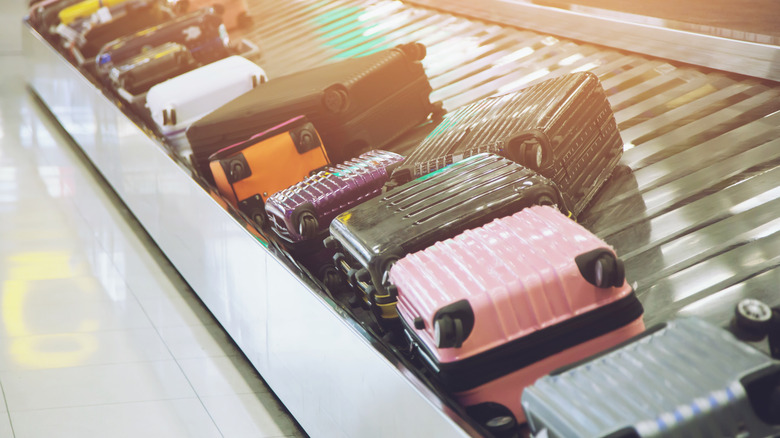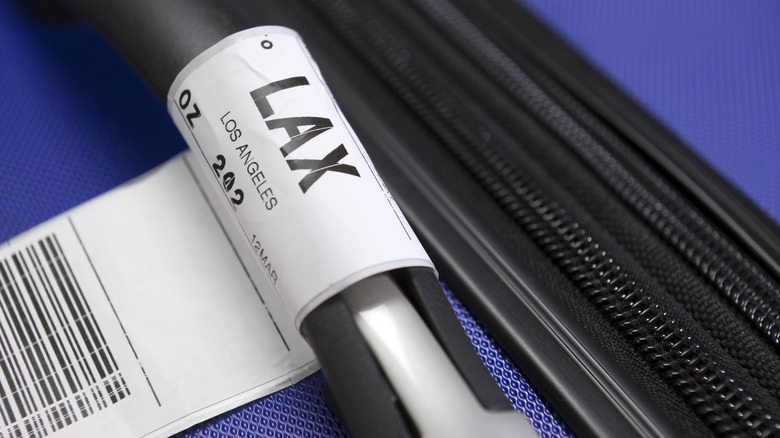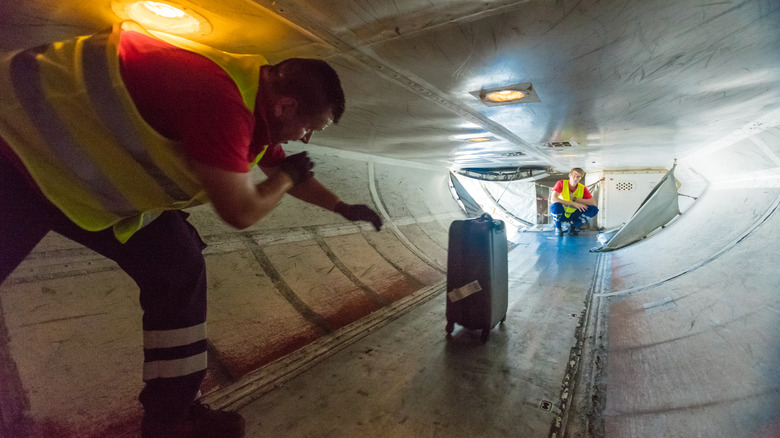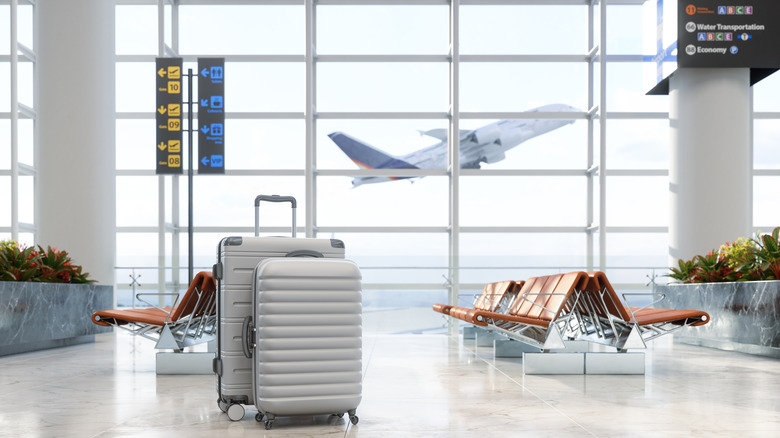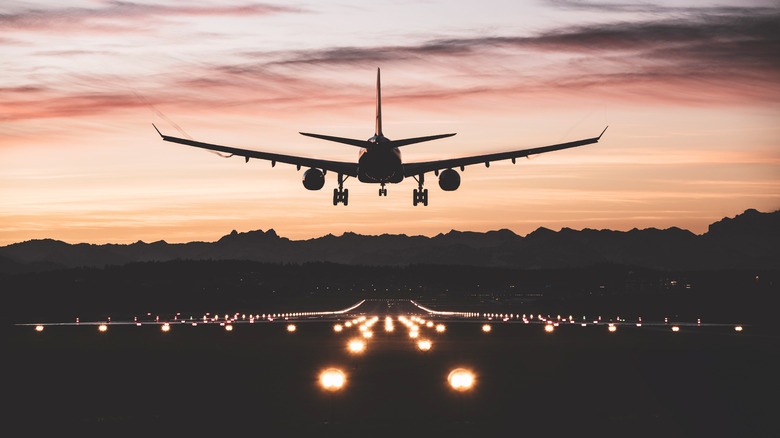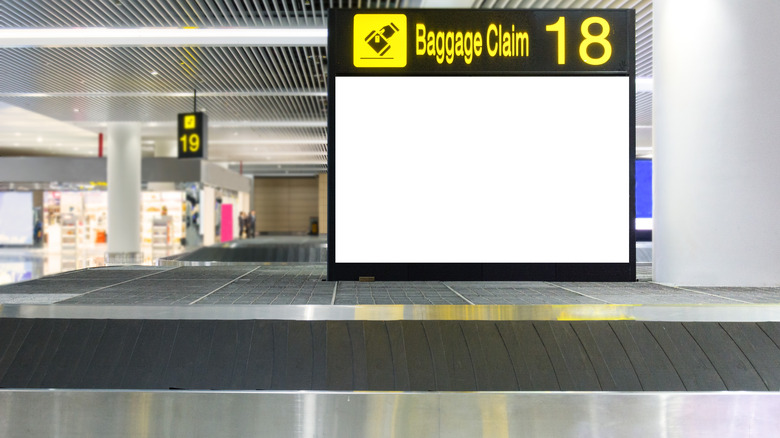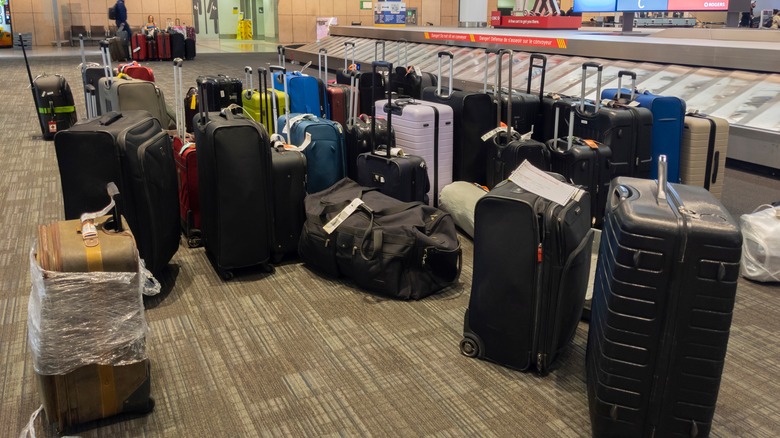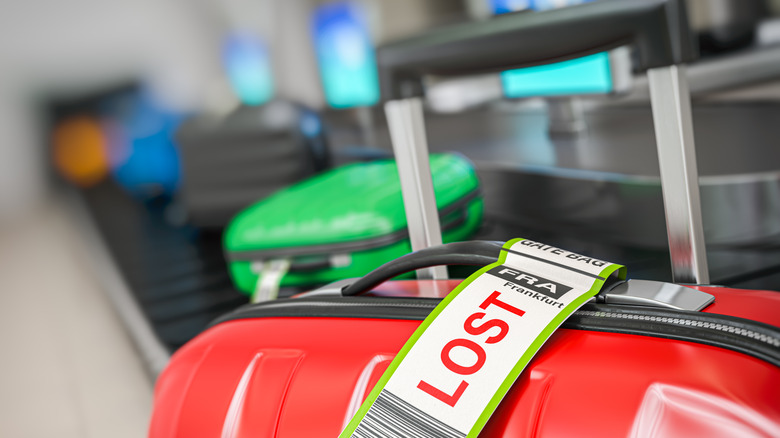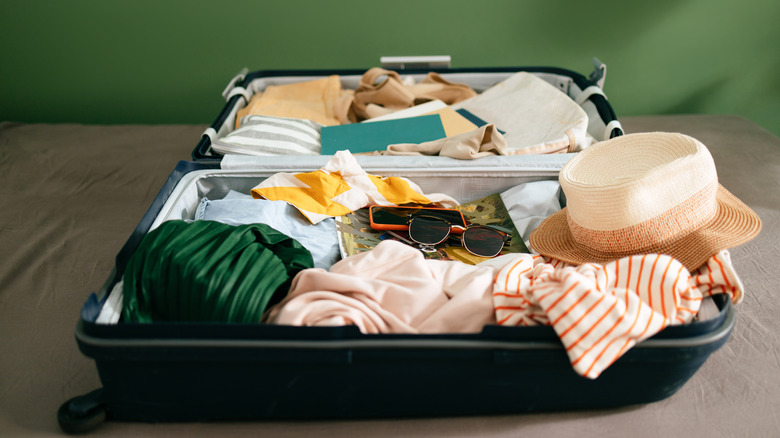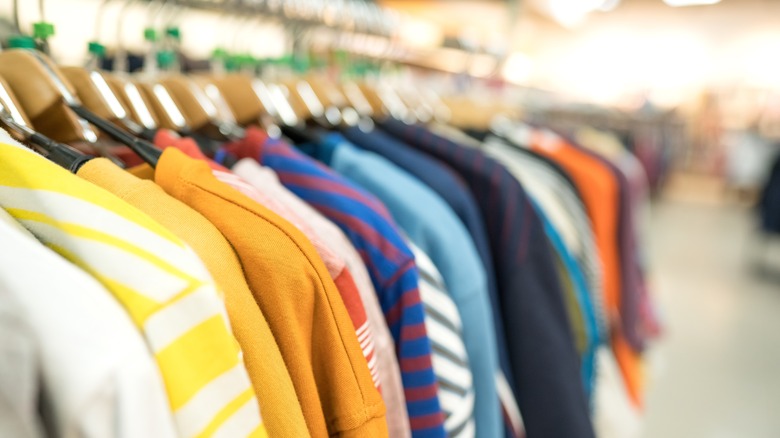Here's What Really Happens To Your Unclaimed Luggage
A familiar sight to anyone who has flown is that of the baggage carousel. A curling, shuffling set of tough plastic or rubber panels that links, twists, and jinks as it winds its way around the arrivals area, the carousel is a practical way to deliver items and also a medium of happiness — it reunites passengers with their beloved bags. And yet it's also tinged with sadness, where solitary pieces of hard-shell luggage, well-worn backpacks, and beaten-up cardboard boxes with illegible labels taped on them do the rounds, forlorn and unrequited, appearing and disappearing on each circuit without anyone there to pick them up.
These pieces of unclaimed luggage, while definitely the exception rather than the norm, are usually caused by a few different reasons, and while some don't stay untaken for long, others are never collected. Taking the process one step further raises questions: Where do these bags end up, who finally processes them, and what becomes of their contents? To answer this, one needs to understand how they ended up orphaned in the first place before tracing the final part of their solitary journey.
What do baggage tags do?
Back in the day, passengers at the airport would patiently stand in line before seeing a check-in agent who would go over documents, weigh suitcases, and place long printed tags on them — the ones with the impossibly sticky backing tape. More recently, much of that procedure takes place at self-service kiosks in the departure halls, boxy consoles with touch screens that let passengers get their boarding passes and even luggage tags, which they place on the bags themselves before depositing them at a baggage-drop counter. The process is certainly more streamlined now, but the basic composition of the baggage tag hasn't changed in decades. These slender rolls of thermal paper are what get a traveler's bag to its destination and ensure that it's ready to collect.
Each tag has information printed on it that intimately links the bag to its owner, and that information typically includes the passenger's flight booking reference, the flights that the bag will go on, the ultimate destination for the bag, and a barcode. Each barcode — which serves as its primary identification — is unique, and it's crucial in the tracking of the bag as it makes its journey from airport to airport. Without the tag, the bag would not be able to get anywhere. Airlines are also now starting to use more advanced technology for tracking suitcases via radio frequency identification (RFID) capability that is more accurate in pinpointing a bag's location and allows for more efficient baggage handling.
How does the luggage get to the right plane?
The journey to the plane varies by airport. Some airports might use the newer RFID technology, but generally the key to everything is that barcode — the equivalent of a passport for each particular piece of luggage. After the airline agent places a suitcase onto a conveyor belt behind the counter, the bag and its tag go off on their merry way to a central baggage handling facility.
Suitcases are first screened to ensure nothing dangerous is in them — similar to the way that carry-on bags for passengers are scrutinized by TSA staff in the departure terminal. After that, scanners read the barcode on each bag and — through a complex system of ramps, belts, and shunting devices — send that bag to the appropriate area for the flight that it is matched to. However, some airlines forgo scanners and manually sort bags. Handlers then place that bag in a pallet or dolly that is then towed to the plane to be loaded into the cargo hold.
The scanners also play another role — they allow the airport's baggage database to capture bag information, in the process creating a record of where the bag is, where it has left, and where it has arrived. This information is vital if a bag goes missing, as it lets airline staff deduce where the bag actually is if it's not at the airport it should be.
What happens during a layover?
Just like for passengers, a layover — the period before a connecting flight — is treated like the gap before the bag's first flight. So the bags will go through a similar regimen, being sent into a central handling area to be scanned, and after the barcode or RFID tag is read, the bag will be routed to its appropriate location.
If the layover between the two flights is short, the bag will just be directed to its next flight pronto. This seamless process, however, only happens if the airlines involved in the connecting flights have interline agreements — an arrangement whereby different airlines engage with each others' passengers and bags and treat them like their own. If all flights are taken on the same carrier, then the baggage is typically always sent through to its final destination without the need for further clearance from the passenger. Without this system, a passenger that takes connecting flights would need to collect the bag at each arrival, and then check it in again for the next segment of the itinerary.
For connecting flights where one is an international flight and one is domestic, passengers might need to check in their bags more than once, though the agent at the airport will advise if that is the case. In addition, if the layover is many hours, the luggage might be stored in a holding area for the next flight before it is relayed to its relevant aircraft — or the airline might ask you to take it back and recheck it to save on storage costs.
What happens to the bags when the flight arrives?
Unlike the procedure when a bag leaves an airport, the journey to the arrivals area is a little less involved. After touchdown, the aircraft will slowly taxi its way to its gate, guided by air traffic controllers and ground staff that use bright batons to shepherd the vessel to its parking bay. At this point, the luggage handlers kick into high gear, opening the cargo hatches, attaching conveyor belts to the hold, and then unloading the bags onto dollies. Once a dolly is full, the contents are then taken to the respective conveyor belt for that flight, eschewing the need to go to a central processing area.
Before the bag is delivered onto the carousel's conveyor system, it might be screened again by airport security, but this is not always the case. It almost certainly will have its barcode or tag scanned again — to create a record that it arrived at its destination — before plopping out on the carousel belt, doing its rounds in the hope that it will be quickly scooped up into the loving arms of its owner.
What are passengers' rights if they don't get their luggage?
Sadly, there are times when a suitcase and its rightful proprietor don't make it onto the same flight. This can happen for a number of reasons, but perhaps the most common is when there is a tight connection time. In these circumstances, a passenger might be able to get onto the connecting flight, but the baggage handling — the unloading, ferrying, scanning, and re-direction of each piece of luggage — might not be able to keep up, and so the bags might never make it onto the second flight. And if you miss your connection because the first flight is delayed, there is a good chance that your bag will suffer the same fate. This can have a knock-on effect, as the bag might not be correctly designated to your updated flight itinerary.
When a bag is delayed, damaged, or lost, the guidelines drafted by the U.S. Department of Transportation clearly detail a passenger's rights and the maximum amount that an airline is expected to offer as reimbursement for a lost bag. One thing passengers should never do if their bag isn't on the carousel at arrivals is to leave the airport before filling out a claim form for the missing bag with the airline — this is the only proof that the carrier will accept that the bag wasn't there, and it won't entertain any claim without one.
Why is some luggage unclaimed?
Conversely to the prior slide, a passenger might miss a connecting flight — but the bag gets to its destination just as the itinerary intended. In this situation, the airline will hold the bag in anticipation of the passenger, who is expected to pick it up in due course. There are also times when flight tags get ripped off of luggage. Part-time ramp agent Zachary Phillips told Thrillist in 2022 that this isn't a frequent occurrence, but it does happen.
When this happens, if there is no personal luggage tag on the suitcase and no piece of paper inside with the owner's details (every flier should put their name and contact information on the inside of their luggage), then the airline staff have no idea who that case belongs to or where it is supposed to be going. While these bags might not end up on a carousel, they do sit unclaimed, their fate to be decided by the airline personnel. Other times, the luggage might end up at the wrong destination, or the passenger might simply forget to collect it. Lost luggage continues to be an unfortunate part of flying. According to a 2023 report from tech company SITA, which works closely with the airline industry, 3.42 billion passengers flew in 2022, and 26 million bags were mishandled — though 80% of these were merely delayed.
Where does the unclaimed luggage go?
Airlines may have a small baggage area at the airport — usually little more than a space at the side or back of their office in the terminal — where they hold bags for a certain period of time. Alternatively, a terminal might have a customer-facing baggage repository for bags that aren't waiting to be loaded onto a flight and need to be picked up. These bags fall into two categories — those for passengers who were delayed and will collect the bag upon arrival, or bags that were delayed and require their passenger to pick it up from the airport.
All this assumes that the airline has given the passenger accurate information about the bag's whereabouts, which is not always the case. Sometimes the passenger doesn't know its location, so the bag sits there, never to be retrieved. Some pieces of luggage — such as those with no tags and not affiliated with any flight — may end up at the airport's lost and found department.How long the bag stays in the airport office before embarking on the next part of its sorry journey varies from carrier to carrier.
What happens with the contents?
After the designated number of days — typically 90, though it depends on the guidelines of the specific carrier — the bag becomes an orphan, and the airline needs to find a way to be free of it. This is not only because the airport has no use for it, but also to free up physical space in its storage area for newer unclaimed bags that might appear. Even as airline technology improves, pieces of luggage still lay around like canvas-clad Jane Does. In fact, mishandled luggage reached a 10-year high in 2022, according to the SITA report.
A bag can be disposed of, donated, or even sold, and a number of organizations specialize in taking this extra stock off an airline's hands. In the United Kingdom, for instance, Baggage Auctions has sites in Glasgow, London, and Manchester where it sells off its haul of airport extras. In the United States, the main operation is Unclaimed Baggage — its first cache in 1970 was unclaimed bus line luggage, and it's been in the business ever since.
Can I buy these items?
In a word, yes. Unclaimed Baggage works with many carriers in the U.S. and has a main hub where it sorts through everything in the bags. Items are divided between those that can be sold, those that can be donated to the less fortunate, and things that have no obvious value but are ideal for recycling. Clothes are thoroughly washed, electronics are checked and any data is wiped clean, and jewelry is even given an appraisal before being listed. The company has a giant store in Alabama that has become a tourist destination in its own right, as well as a haven for regular shoppers.
For bargain hunters (Unclaimed Baggage claims to sell products at up to 80% below retail) who aren't in the area, it also has a comprehensive online store. Browse the store's website and you can find items that are new (even with original tags on them), from clothing to computers, as well as haute jewelry and handbags, swimwear for kids, wallets for men, and coats for women. There are even sections for "Luxe Finds" and "Back to School," meaning that unclaimed luggage, disheartening as it is, doesn't go to waste.
